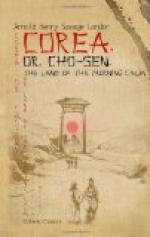Then come the padded socks, in which the huge trousers are tucked, and which are fastened round the ankle with a ribbon. And, lastly, now we come to the shoes. Those used by the better classes are made of hide, and have either leather soles with nails underneath, or else wooden soles like the Chinese ones with the turned-up toes. The real Corean shoe, however, as used every day for walking and not for show, is truly a peculiar one. The principal peculiarity about it is that it is made of paper; which sounds like a lie, though indeed it is not. Another extraordinary thing is that you can really walk in them. If you do not believe it, all you have to do is to take the first steamer to Corea and you can easily convince yourself of the fact. The greater part of the population wears them, and the Mapus especially walk enormous distances in them. They are scarcely real shoes, however, and one should, perhaps, classify them rather as a cross between a shoe and a sandal, for that is just what they are. The toes are protected by numberless little strings of curled untearable paper, which, when webbed, make the sole, heel, and back of the sandal, and this is joined to the point of the shoe by a stouter cord going right round, which is also made of the same kind of twisted paper. This cord can be fastened tighter or looser to suit the convenience of the wearer of the sandal-shoe.
The Corean is an unfortunate being. He has no pockets. If his hands are cold he must warm them by sticking them down his belt into his trousers, and if he be in company with people, he can generate a certain amount of heat by putting each into the other arm’s sleeve. As for the money, tobacco, &c, that he wants to carry, he is compelled to provide himself with little silk bags, which he attaches to his waist-band or to the ribbon of his coat. These bags are generally of orange colour or blue, and they relieve a little the monotony of the everlasting white dresses.
The clothing, so far as I have described it, is, with the exception of the shoes, that which is worn habitually in the house by the better classes of the people; the officials, however, wear a horse-hair high cap resembling a papal tiara on the head, instead of the other form of hat. Indoors, the shoes are not worn, the custom of Japan being prevalent, namely, to leave them at the door as one mounts the first step into the room. The middle lower classes and peasantry are seldom found parading the streets with anything besides what I have described, with the exception of the long pipe which they, like the Mapu or the coolies, keep down the back of the neck when not using it. Merchants, policemen, and private gentlemen are arrayed, in winter especially, in a long cotton or silk gown similarly padded, an overall which reaches below the knees, and some, especially those in the Government employ, or in some official position, wear either without this or over this an additional sleeveless




